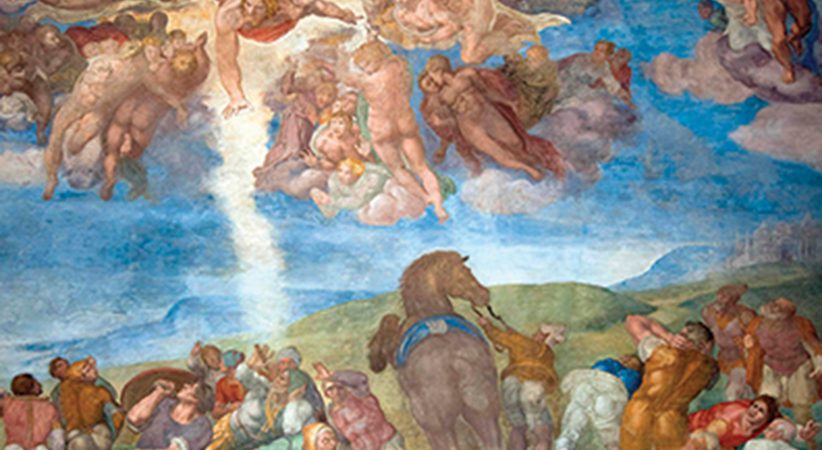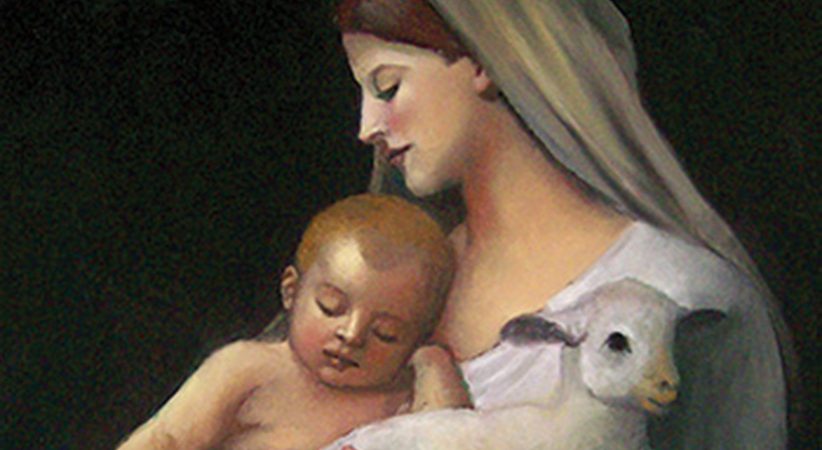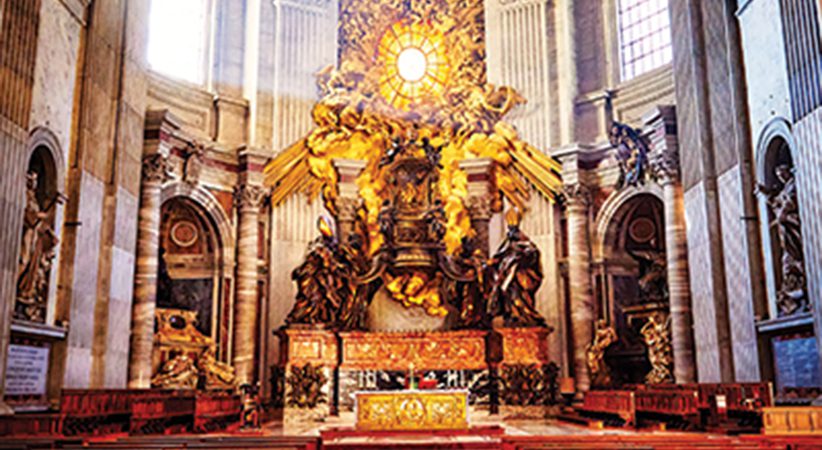‘Mount Tabor’ Experiences
Coming down the mountain of our own transfiguration
Father Jeffrey Kirby Comments Off on ‘Mount Tabor’ Experiences
This month, as we liturgically celebrate the feast of the Transfiguration, we are reminded of the very first Mount Tabor experience. As Peter, James and John saw and felt the glory of the Lord Jesus, so each of us in our own ways has undergone such moments in our own walk with the Lord. Such occasions are euphoric and life-changing. They help us to see — and feel — the presence of the Lord in our own lives.
The Transfiguration was so profound in the life of St. Peter that later, at the end of his life, he still recounted the experience: “We did not follow cleverly devised myths when we made known to you the power and coming of our Lord Jesus Christ, but we had been eyewitnesses of his majesty. For he received honor and glory from God the Father when that unique declaration came to him from the majestic glory, ‘This is my Son, my beloved, with whom I am well pleased.’ We ourselves heard this voice come from heaven while we were with him on the holy mountain” (2 Pt 1:16-18).
“Mount Tabor” moments are enchanting and uplifting. But they always end, and the grace that we receive from them must be put to work. When St. Peter asked to pitch some tents on the mount, Jesus refused. As they left the mount, the Lord’s public ministry continued, with healings, exorcisms, hard sayings and all. The Lord’s passion still loomed, and he would readily undergo its tortures.
No Christian can expect to live on Mount Tabor or carry their discipleship on Mount Tabor experiences. They are gifts. Such moments come and such moments go, even if we prefer that they stay.
The reality of the passing of Mount Tabor moments provides us with an opportunity to dive into our ascetical tradition. It gives us an open door to learn again about the movements of God in our souls and the importance of the dry and quiet moments in our discipleship. Such experiences are traditionally associated with the purgative way in ascetical theology. And so, it’s good for us to kiss the euphoria goodbye, lick our wounds and understand the spiritual value and importance of the purgative way.
St. Paul expressed the heart of the purgative way when he wrote: “Three times I begged the Lord about this, that it might leave me, but he said to me, ‘My grace is sufficient for you, for power is made perfect in weakness. I will rather boast most gladly of my weaknesses, in order that the power of Christ may dwell with me” (2 Cor 12:8-9).
Our task, therefore, is to explore the purgative way, so we can understand that our discipleship will not always be easy or comfortable. It will be difficult, but it’s all worth it. By knowing the broader horizon that ascetical theology gives to us, we can see the glory and know the goodness of the battle that’s presented by the purgative way. St. Paul guides us on this task, as he writes, “I consider that the sufferings of this present time are as nothing compared with the glory to be revealed for us” (Rom 8:18).
First Conversion
In ascetical theology, conversion refers to a turning away from sin and death and a turning toward grace and life. The purgative way is one of three ways in which we experience conversion through various stages to reach an ever-greater intimacy with God. The Scriptures describe this as obtaining “grace in place of grace” (Jn 1:16).
The three ways of the supernatural life — the purgative, illuminative and unitive — reflect the gradual workings of God. As with humanity and the Church in the course of salvation history, so with each of us now amid the Church, God progressively reveals himself and allows his grace to transform us into his likeness.
The first conversion happens in our lives when God bestows an actual grace of some great awareness — usually through a crisis, difficulty or a general sense of being lost. The first conversion is a gift to each of us, a type of awakening of our souls that helps us to hear the call of the Lord Jesus. It has the rich spiritual fruit of allowing us to see our complete unworthiness and our total need for Jesus Christ and the workings of grace. Although called “first,” such a conversion can happen multiple times in our lives and can be repeated if we fall into sin or regress in our efforts to grow in our relationship with the Lord.
If we accept the graces of a first conversion, then our soul enters the purgative way, which is the first real beginning of our cooperation with grace and a nurturing of the supernatural life within us. The purgative way is also given in later times in the spiritual life, such as after a great illumination. As such, the purgative way is an ongoing means by which God leads us to abandon a life according to the flesh and so walk according to his grace.
Those who live according to the flesh set their minds on the things of the flesh, but those who live according to the Spirit set their minds on the things of the Spirit. To set the mind on the flesh is death, but to set the mind on the Spirit is life and peace (cf. Rom 8:5-6).
Interior Purification
The purgative way is an interior purification of our souls. It is a divine ordering and maturing of ourselves to the supernatural life given to us in Jesus Christ.
In the purgative way, God’s grace leads us through a reliving of the Paschal Mystery — Christ’s own passion, death and resurrection — which purifies, heals and reconstitutes who we are in Jesus Christ.

St. Paul expresses this reality, when he writes, “I have been crucified with Christ; yet I live, no longer I, but Christ lives in me; insofar as I now live in the flesh, I live by faith in the Son of God who has loved me and given himself up for me” (Gal 2:19-20).
The purgative way has two principal phases within our souls: first, a time of consolation (hence, the Mount Tabor moments), and second, a time of darkness and desolation. These phases are oftentimes repeated within our souls as we walk with the Lord Jesus.
As we enter the purgative way, we receive abundant actual grace of consolation. As described in ascetical theology, this phase is marked by immense comforts, joys and encouragement. It’s as if God is throwing a grand party in our souls. Such actual grace is given because the soul is just beginning to deepen in the supernatural life of God within it. God is comforting and indulging the soul to help it to persevere.
After the time of consolation, the next phase of the purgative way begins. It is much more di cult and more properly purgative. At times, a soul in this part of the purgative way might think that it is undergoing a dark night of the soul or a “dark night of the senses.” While the person may think that such a phenomenon is happening to him, such experiences only happen at higher levels of the supernatural life. For our purposes, it’s worth noting that the dark night of the senses and the dark night of the soul are far more severe than the darkness that’s experienced by a soul in the purgative way.
In terms of the proper purgative process, it can be very abrupt. The consolations we once felt interiorly suddenly come to an end. The great party in our soul concludes. There is silence. Our soul feels alone. It is restless in perceived darkness. In this process, the graces of consolation are replaced by the graces of obedience (which comes from a Latin word meaning “to listen”). In this portion of the purgative way, our soul is now called to persevere through a purification of self-love and pride.
In the darkness of the purgative way, God reorients our soul and leads it to spiritual maturity. Our feelings, which usually want to betray us and deceive us, are spiritualized and channeled to a love of God and perseverance in the supernatural life.
Since it belongs to the supernatural order, grace escapes our experience and cannot be known except by faith. We cannot, therefore, rely on our feelings or our works to conclude that we are justified and saved.
While our feelings may not experience it, God is close to us in the purgative way and can bring about a greater work within us than during the time of consolation. It is very important that we realize the place and purpose of this purgative darkness. Many times, those in this phase of the purgative way falsely believe that it’s a sign that they have done something wrong, or have offended God or have been abandoned by him. None of these is true.
In the purgative way, we must exercise the infused virtues of faith, hope and love. We must cling to the sure knowledge of the workings of grace within us. We must persevere through this supernatural version of surgery on our souls.
As the Letter to the Hebrews reminds us: “Endure your trials as ‘discipline’; God treats you as sons. For what ‘son’ is there whom his father does not discipline? If you are without discipline, in which all have shared, you are not sons but bastards. At the time, all discipline seems a cause not for joy but for pain, yet later it brings the peaceful fruit of righteousness to those who are trained by it” (12:7-8, 11).

The Purpose of the Purgative Way
While in the purgative way, God heals our wounds, lessens our egotism, grows our spirit, exposes our inordinate self-love and names any bad spirits within us. He shows us the harm caused by sin.
In the purgative way, we struggle and wrestle to abandon sin and our wayward attraction to sin. We begin to yearn for a growth in the supernatural life. We pine to live fully as the children of God and want to love the Lord Jesus with all our being. We strongly desire to live a life in the Spirit.
In the purgative way, we accept an interior summons to abandon a life of sin and self-centeredness and to seek a supernatural life of love and self-donation.
The purgative way is neither easy nor comfortable. God lets us fully experience our own weakness and our total helplessness before him. There is spiritual suffering; a death to ourselves, our emotions and our self-absorption; a total and heartfelt exercise of faith in God alone; a complete trust in him; and a radical desire to love God for himself and for no other reason. It is an outpouring of ourselves to God. It is the workings of grace forming us into an oblation, a living sacrifice, to the eternal God.
As God works in our souls in the purgative way, he is present to us (although veiled) and his grace is actively working to bring forth a new identity within us. Such a process can be a time of great anxiety and restlessness. As such, the purgative way is a time for us to remain vigilant and to pray for the graces of perseverance.
Moments of Illumination
After some duration in the purgative way, God will grant an actual grace of illumination. We will understand some truth of the supernatural life in a profoundly interior and robust way. It might be something we already cognitively knew or thought we understood, but the illumination deepens or brightens our understanding of it.
Ascetical theology highlights many people undergoing this illumination with words of mercy and hope, especially in the initial stages of conversion. Of course, God will illuminate the soul in the areas in which it is most in need. After an illumination, it is common that the soul will be taken back to the purgative way and the process repeats itself as the soul cooperates with grace and grows in the supernatural life.
This is the journey of redemption and holiness in Jesus Christ. It shows us how our Mount Tabor moments are actual graces and how they can lead us into harder — but more fruitful — processes in the spiritual life. Each stage of the spiritual life is a gift so that we can always draw closer to the God who loves us and desires us to be with him.
FATHER JEFFREY KIRBY, STD, is the pastor of Our Lady of Grace Parish in Indian Land, South Carolina. Portions of his article were taken from his recent book, “Glory Unto Glory: A Primer on Ascetical Theology” (Angelico Press, $16.95).
………………………………………………………………………………………………………………………………………………………..
Transfigured on the Mountain
The Catechism of the Catholic Church says of the Transfiguration: “For a moment Jesus discloses his divine glory, confirming Peter’s confession. He also reveals that he will have to go by the way of the cross at Jerusalem in order to ‘enter into his glory.’ Moses and Elijah had seen God’s glory on the Mountain; the Law and the Prophets had announced the Messiah’s sufferings. Christ’s Passion is the will of the Father: the Son acts as God’s servant; the cloud indicates the presence of the Holy Spirit. ‘The whole Trinity appeared: the Father in the voice; the Son in the man; the Spirit in the shining cloud.’
“You were transfigured on the mountain, and your disciples, as much as they were capable of it, beheld your glory, O Christ our God, so that when they should see you crucified they would understand that your Passion was voluntary, and proclaim to the world that you truly are the splendor of the Father.
“On the threshold of the public life: the baptism; on the threshold of the Passover: the Transfiguration. Jesus’ baptism proclaimed ‘the mystery of the first regeneration,’ namely, our Baptism; the Transfiguration ‘is the sacrament of the second regeneration’: our own Resurrection. From now on we share in the Lord’s Resurrection through the Spirit who acts in the sacraments of the Body of Christ. The Transfiguration gives us a foretaste of Christ’s glorious coming, when he ‘will change our lowly body to be like his glorious body.’ But it also recalls that ‘it is through many persecutions that we must enter the kingdom of God.’” (Nos. 555-556).
………………………………………………………………………………………………………………………………………………………….





